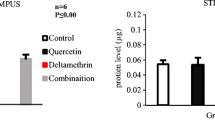Abstract
Recent toxicological studies have demonstrated that exposure to organochlorine pesticides is susceptible to produce various alterations in brain cell which significantly contribute to a loss in neurobehavioral skills and disturbance of neuronal function. Acetamipride (AC) is belonging to this organochlorines family and it is considered less harmful by toxicovigilance systems and practices in Algeria. The aim of this work was mainly to evaluate the impact of this pesticide on the brain cell integrity and function in Acetamiprid-treated rats at the dose of 3.14 mg/kg (1/60 Lethal Dose) daily during 3 months. Several indicators of neuronal apoptosis and function have been rated, in addition to classical labyrinth and Maze tests monitoring to evaluate learning and memorization abilities in rats exposed to this neonicotinoid. The results of this study have shown significant enhancing of cytochrome-c(p<0.01) and Caspase-3(p<0.001) activities in brain lysates of treated group that is correlated with induction of apoptosis. At the same time, assessment of neurotrans-mitters brain cells has recorded a significant increase (p<0.01) in adrenaline rate and a significant decrease in cerebral level of dopamine (p< 0.01), serotonin (p<0.001) and Acetylcholin esterase in the same group comparing to control. Furthermore, neurobehavioral study has shown a strong correlation between the unbalance observed in neurotransmitters homeostasis and the significant (p<0.01) loss of learning, memorization and locomotive potential as demonstrated by the increase in arrival time(S) (10.33±3.14) versus (3.33±2.05) in control. In conclusion, exposition of the rats to Acetamiprid generates apoptosis which is induced by releasing of mitochondrial Cytochrome-c in cell cytosol and alters neurotransmitters rates that could reduce the potential of learning and memorization in the rats.
Similar content being viewed by others
References
Hatcher, J. M., Pennell, K. D. & Miller, G. W. Parkinson's disease and pesticides: a toxicological perspective. Trends Pharmacol. Sci. 29, 322–329(2008).
Lahouel, A. et al. Neurobehavioral deficits and brain oxidative stress induced by chronic low dose exposure of persistent organic pollutants mixture in adult female rat. Environ. Sci. Pollut. Res. 23, 19030–19040(2016).
Syam, S. Trends in the application of high-resolution mass spectrometry for human biomonitoring: An analytical primer to studying the environmental chemical space of the human exposome. Environ. Int. 100, 32–61(2017).
Wilson, W. Developmental Exposure to the Organochlo-rine Insecticide Endosulfan Alters Expression of Proteins Associated with Neurotransmission in the Frontal Cortex, SYNAPSE. 68, 485–497(2014).
Alan, G. & Porter, A. R. Emerging roles of caspase-3 in apoptosis. Cell Death Differ. 6, 99–104(1999).
Mrema, E. J., Rubino, F. M., Brambilla, G., Moretto, M. & Tsatsakis, A. M. Persistent organochlorinated pesticides and mechanisms of their toxicity. Toxicol. 307, 74–88(2012).
European Food Safety Authority (EFSA). Scientific Opinion on the developmental neurotoxicity potential of. EFSA Journal11, 1–51(2013).
Tian, Y. Y. W. A colorimetric detection method of pesticide acetamiprid by fine-tuning aptamer length. Analy. Biochem. 23, 45–57(2016).
Fernandez, V. C, Sancho, E., Ferando, M. D. & Andreu, M. E. Thiobencarb induced changes in acetylcholinesterase activity of the fish Anguilla Anguilla. Pestic. Biochem. and Physiol. 72, 55–63(2002).
Chakroun, S. et al. Hematological, biochemical, and toxicopathic effects of subchronicacetamiprid toxicity in Wistar rats. Environ. Sci. Pollut. Res. 23, 25191–25199(2016).
Lakroun, Z., Kebieche, M., Lahouel, A., Zama, D. & Soulimani, R. Oxidative stress and brain mitochondria swelling induced by Endosulfan and protective role of quercetin in rat. Environ. Sci. Pollut. Res. 22, 7776–7781(2015).
Shi, Y. et al. Benzene hexachloride induces apoptosis of rat Sertoli cells through generation of reactive oxygen species and activation of JNKs and FasL. Environ. Toxicol. 26, 124–135(2011).
Shi, Y. Q. et al. Induces testicular apoptosis in prepubertal rats via the Fas/FasL pathway. Toxicol. Lett. 193, 79–85(2010).
Di-Monte, D. A. & Lavasani, M. Manning-Bog AB. Environmental factors in Parkinson's disease. Neuro-toxicology23, 487–502(2002).
Sara, H. et al. Oxidative stress status, caspase-3, stromal enzymes and mitochondrial respiration and swelling of Paramecium caudatum in responding to the toxicity of Fe3O4 nanoparticles. Toxicol. Environ. Health Sci. 8, 161–169(2016). Doi: 10.1007/sl3530-016-0273-l.
Hussein, S. A., Abdel-Aal, S. A. & Khalaf, H. A. Che-mopreventive Role of Curcumin in benzo (A) pyrene induced Lung Carcinogenesis in mice via-modulation of Chemopreventive Role of Curcumin in benzo (A) pyrene induced Lung Carcinogenesis in mice COX-2 and antioxidant defense system in Lung tissue. Int. J. Pharma. Sci. 6, 1616–1622(2016).
Sherer, B. T. An in Vitro Model of Parkinson's disease: Linking Mtochondrial Impairment to Altered Synucle-in Metabolism and Oxidative Damage. J. of Neurosci. 22,7006–7015(2002).
Gasmi, S. et al. Effects of Deltamethr in on striatum and hippocampus mitochondrial integrity and the protective role of Quercetin in rats. Environ. Sci. Pollut. Res. 24, 16440–16457(2017).
Gao, C. et al. Myocardial mitochondrial oxidative stress and dysfunction in intense exercise: regulatory effects of quercetin. Eur. J. Appl. Physiol. 114, 695–705(2014).
Banerjee. B. D., Seth. V. & Rs. A. Pesticide-induced oxidative stress: perspectives and trends. Environ. Health16, 1–40(2001).
Chahinez, T. et al. Toxicity of Fe3O4 nanoparticles on oxidative stress status, stromal enzymes and mitochondrial respiration and swelling of Oryctolaguscuniculus brain cortex. Toxicol. Environ. Health Sci. 8, 349–355(2016).
Testud, F. Insecticides neonicotinoides. EMC-Patholo-gie professionnelle et de l'environnement. EMC Toxicol. Pathol. 9, 1–6(2014).
Pettmann, B. & Henderson, C. E. Neuronal cell death. Neuron. 20, 633–647(1998).
Myburgh, J. A. et al. Comparison of epinephrine and norepinephrine in critically ill patients. Intensive Care Med. 34, 2226–2234(2008).
Reneman, L. Memory disturbances in “Ecstasy” users are correlated with an altered brain serotonin neurotransmission. Psychopharmacol. 148, 322–324(2002).
Ikonomidou, C. et al. Neurotransmitters and apoptosis in the developing brain. Biochem. Pharmacol. 62, 401–405(2001).
Zhang, H. Mesoionicpyridopyrimidinones: Discovery of dicloromezotiaz as a lepidoptera insecticide acting on nicotinic acetylcholine receptors. Bioorg. Med. Chem. Lett. 15, 911–917(2017).
Karami-Mohajeri, S. and Abdollahi, M. Toxic influence of organophosphate, carbamate, and organochlo-rine pesticides on cellular metabolism of lipids, proteins, and carbohydrates: A systematic review. Hum. Exp. Toxicol. 30, 1119–1140(2011).
Bernhoorn, I. E. J. & Van, V. J. H. J. The use of different enzymes in feral freshxater as a tool for the assessment of water pollution in Africa. Ecotoxical. Environ. Saf. 59, 180–185(2004).
Gao, H. et al. The accumulation of brain injury leads to severe neuropathological and neurobehavioral changes after repetitive mild traumatic brain injury. Brain Research15, 1–8(2017).
Zoumenou, B. M. Effets toxicologiques et methodes d'analyse de la lambda-cyhalothrine et de l'acetamipri-deutilisesdans la protection phytosanitaire du cotonnier. Int. J. Biol. Chem. Sci. 9, 2184–2199(2015).
Gasmi, S. et al. Alteration of membrane integrity and respiratory function of brain mitochondria in the rats chronically exposed to a low dose of acetamiprid. Environ. Sci. Pollut. Res. 24, 22258–22264(2017).
Clayton D. A. and J. N. Doda. Isolation of mitochondria from cells and tissues: A laboratory manual, D. L. Spec-tor, R. Goldman and L. Lei wand, Ed. Sci. Press, Beijing, Chaina, 356–361(2001).
Ellman, G. L., Courtney, K. D., Andres, V. & Feather-stone, R. M. A new and rapid colorimetric determination of acetylcholinesterase activity. Biochem. Pharmacol. 7, 88–95(1961).
Jaako, K. T. Developmental lead exposure impairs contextual fear conditioning and reduces adult hippo-campal neurogenesis in the rat brain. Int. J. Develop. Neurosci. 23, 627–635(2005).
Acknowledgments
First, our thanks are addressed to DGRSDT of Algeria for its support. All the labs to which the co-authors are affiliated are also thanked for authorizing our team to achieve this work.
Author information
Authors and Affiliations
Corresponding authors
Ethics declarations
All applicable international, national, and/or institutional guidelines for the care and use of Rats were followed.
Additional information
Conflict of Interest
Salim Gasmi declares that he has no conflicts of interest. Smail Chafaa declares that he has no conflicts of interest. Zhora Lakroun declares that she has no conflicts of interest. Rachid Rouabhi declares that he has no conflicts of interest. Chouaib Touahria declares that he has no conflicts of interest. Mohamed Kebieche declares that he has no conflicts of interest. Rachid Soulimani declares that he has no conflicts of interest.
Rights and permissions
About this article
Cite this article
Gasmi, S., Chafaa, S., Lakroun, Z. et al. Neuronal Apoptosis and Imbalance of Neurotransmitters Induced by Acetamiprid in Rats. Toxicol. Environ. Health Sci. 11, 305–311 (2019). https://doi.org/10.1007/s13530-019-0417-1
Received:
Revised:
Accepted:
Published:
Issue Date:
DOI: https://doi.org/10.1007/s13530-019-0417-1




